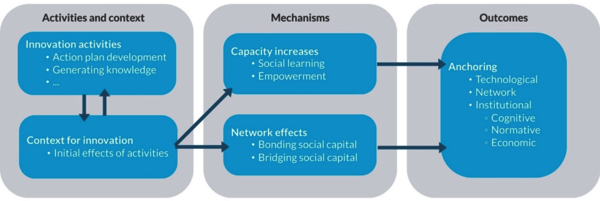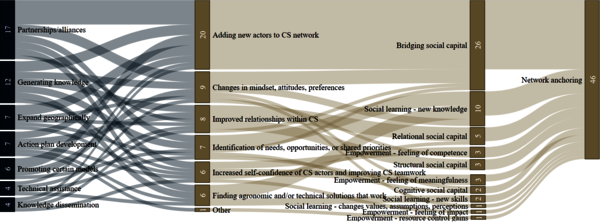Each case study (CS) in DiverIMPACTS carried out a number of activities in an effort to achieve their vision and mission on crop diversification. The 25 case study leaders were thus faced with the task of developing an effective set of activities but with very little guidance on what would work or not. We analysed the CS activities and their stated effects to arrive at guidelines for more effective innovation.
We asked the 25 CSs about the ‘most significant activities’ they had developed over the course of the project, and how effective these activities had been in connecting the crop diversification ideas to the outside world. These questions took the form of a Learning History, which also helped the CSs to reflect on their own trajectories together with their actors.
Using methods from the field of critical realist evaluation, we analysed the Learning Histories of (so far) 6 typical CSs using the concept of ‘anchoring’. Anchoring refers to the initiation and strengthening of links between niches (i.e. the crop diversification initiatives in the case studies) and the regimes (i.e. the ways in which things are normally done). In this perspective, anchoring is the result of CS activities, which affect the CS context and trigger broader social mechanisms (Figure 1). Social mechanisms that are distinguished in the literature include increases in the capacities of people involved in the innovation, and network formation. Three forms of anchoring can be distinguished:
- network anchoring: connecting the innovators to supporting networks
- technological anchoring: having agreement among actors about how the innovation will work technically
- institutional anchoring: involves sharing of visions, rules, and economic arrangements that support the innovation
Figure 2 illustrates the various types of network anchoring. The activities of the six cases resulted in 46 instances of network anchoring. The dominant mechanism leading to successful network anchoring was “bridging social capital”, which refers to the capacity to effectively connect with individuals or groups outside the network of CS actors. Such “bridging social capital” was particularly promoted by adding new actors to the CS network and by activities that resulted in changes in mindset, attitudes, or preferences. Activities that were helpful in creating these effects were activities that resulted in partnership building, but we also found activities to be effective that generated new knowledge, or were directed at demonstration of the innovations. When completed, the results will show how the most significant activities of the CSs are linked to anchoring outcomes, which will support new case study leaders in choosing among activities to bring about aspired anchoring outcomes.


 tap and then scroll down to the Add to Home Screen command.
tap and then scroll down to the Add to Home Screen command.
Disqus
In order to use the comment function, you must register with the third-party provider "Disqus".
When you activate this function, your browser establishes a direct connection with the servers of the third-party provider. We would like to point out that data is transmitted to the third-party provider after activation, and the latter may set cookies that can also be used for analysis and marketing purposes. For more information, please refer to our privacy policy.
Activate